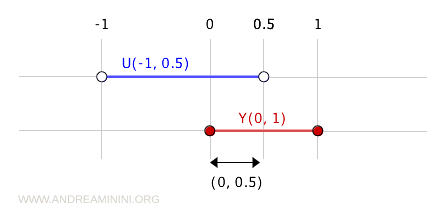Continuity of an inclusion function in topology
If \( X \) is a topological space and \( Y \) is a subset of \( X \), the inclusion function \( f : Y \to X \) is defined by \( f(y) = y \) for every \( y \in Y \). This function is continuous.
An inclusion function maps elements from a subset \( Y \) to its larger containing space \( X \).
In other words, the inclusion function \( f \) assigns each element of \( Y \) to the corresponding element in \( X \).
This function is continuous in a topological sense.
Note: The inclusion function is not the same as the identity function, although they may seem similar at first. The inclusion function maps from a subset to a larger space, while the identity function maps each element within a space to itself.
Why is it continuous?
In topology, a function is continuous if, for every open set \( U \) in \( X \), the preimage of \( U \) under \( f \), written as \( f^{-1}(U) \), is open in \( Y \).
According to the definition of the subspace topology, the open sets in \( Y \) are precisely the intersections of the open sets of \( X \) with \( Y \).
$$ f^{-1}(U) = U \cap Y $$
Since \( f^{-1}(U) = U \cap Y \) is always open in \( Y \) whenever \( U \) is open in \( X \), the function \( f \) is continuous by definition.
Note: This demonstrates how the subspace topology on \( Y \) is designed to ensure the inclusion function is continuous.
A practical example
Let’s consider the topological space \( X = \mathbb{R} \) (the real number line) and its subset \( Y = (0, 1) \), the open interval between 0 and 1.
The inclusion function \( f : Y \to X \) is defined by \( f(y) = y \) for all \( y \in Y \).
$$ f(y) = y \ \ \ \text{for all} \ \ y \in (0,1) $$
In simple terms, this means the function \( f \) "places" the points of \( Y \), which are the numbers in the open interval \( (0, 1) \), into the space \( X \), which is the entire real number line \( \mathbb{R} \).
In the subspace topology, for any open set \( U \) in \( X \), the intersection \( U \cap Y \) is an open set in \( Y \).
For example, take the open interval \( U = (-1, 0.5) \subset \mathbb{R} \) in the standard topology on \( X \).

The intersection of this open set with \( Y = (0, 1) \) is:
$$ U \cap Y = (-1, 0.5) \cap (0, 1) = (0, 0.5) $$
This gives us an open interval within the set \( Y = (0, 1) \).
Thus, \( U \cap Y = (0, 0.5) \) is open in the subspace topology on \( Y \).
Since for every open set \( U \) in \( X \), the intersection \( U \cap Y \) is an open set in \( Y \), the inclusion function \( f : Y \to X \) is continuous.
And so on.
